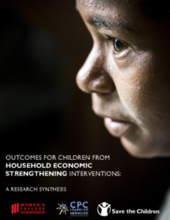EXECUTIVE SUMMARY
Traditionally, Economic Strengthening (ES) programmes have focused on the head of the household and were designed on the assumption that any benefits would trickle down to other members of the household including children. Despite this assumption, the impacts of ES on children’s wellbeing were rarely evaluated. However, more recently, external research has begun to evaluate and measure the impacts for children leading to some interesting and informative results for those designing and managing ES programmes.
This review focuses on the findings from high-quality published evaluation research into economic strengthening (ES) programs, implemented by NGOs, in resource-poor environments in the developing world, where external evaluators measured impacts on any of a wide variety of indicators of children’s or youth’s protection and wellbeing. A total of 46 published or publicly-available randomized control trial (RCT) research reports were selected for inclusion.1 35 evaluations measured the impact of programs in which the caregivers were the direct beneficiaries, and 12 measured the impact of programs in which adolescents or youth were the direct beneficiaries.
The review sets out to identify the ES programmes that impact child wellbeing outcomes positively as well as those that have potentially negative impacts. It also attempts to understand how factors such as gender and age might influence positive or negative impacts on child wellbeing outcomes. Lastly, the review identifies gaps in the evidence and makes recommendations for further research.

